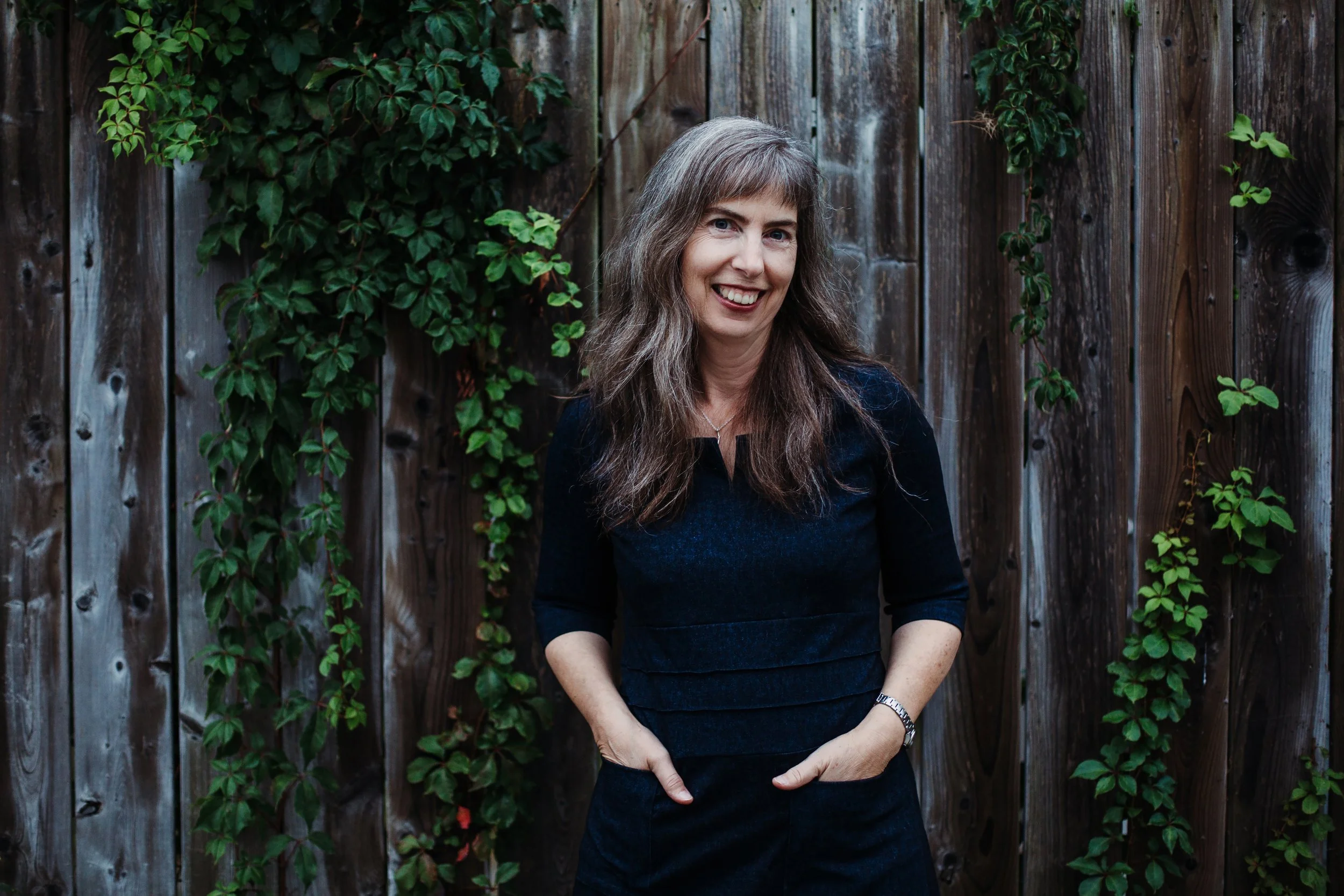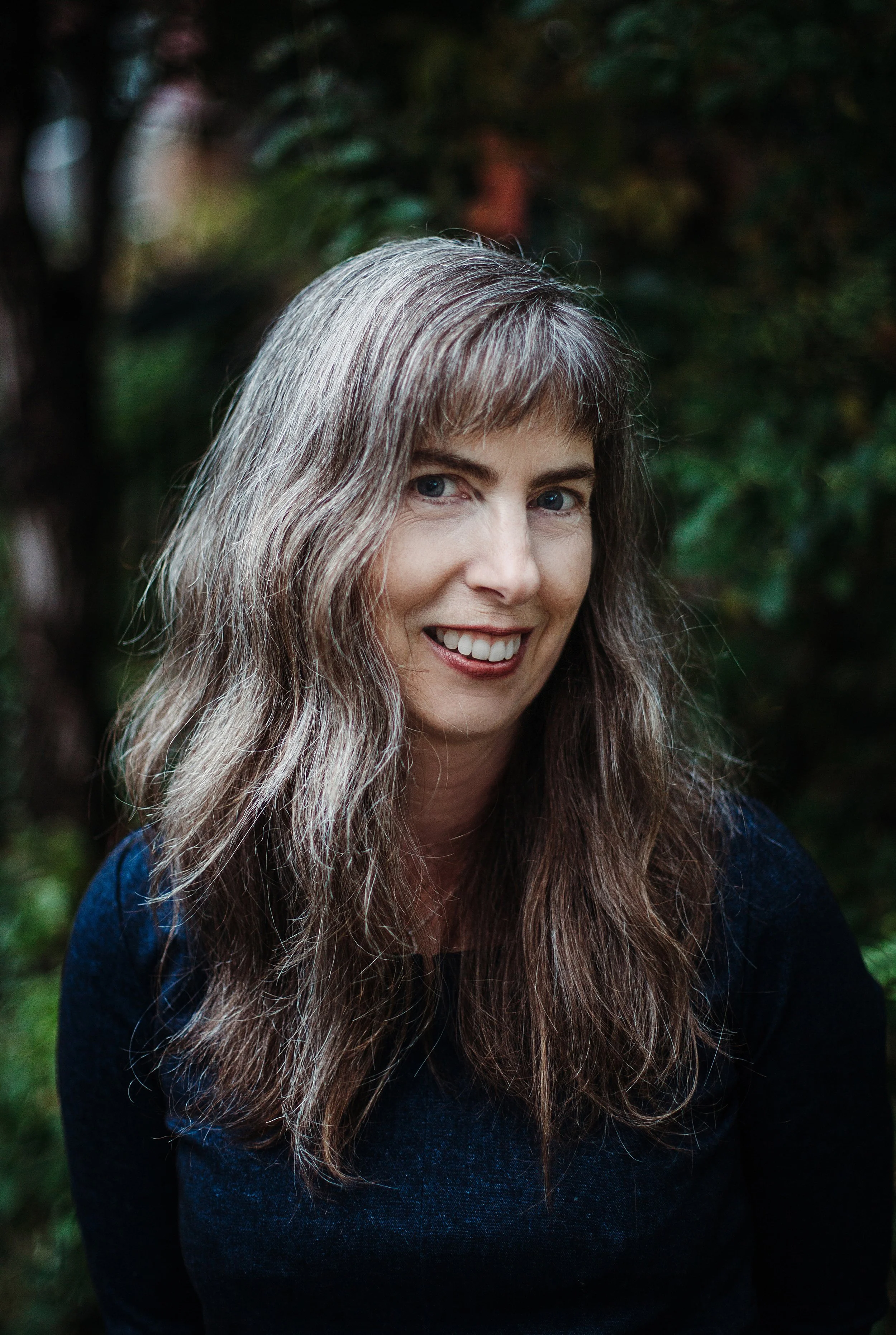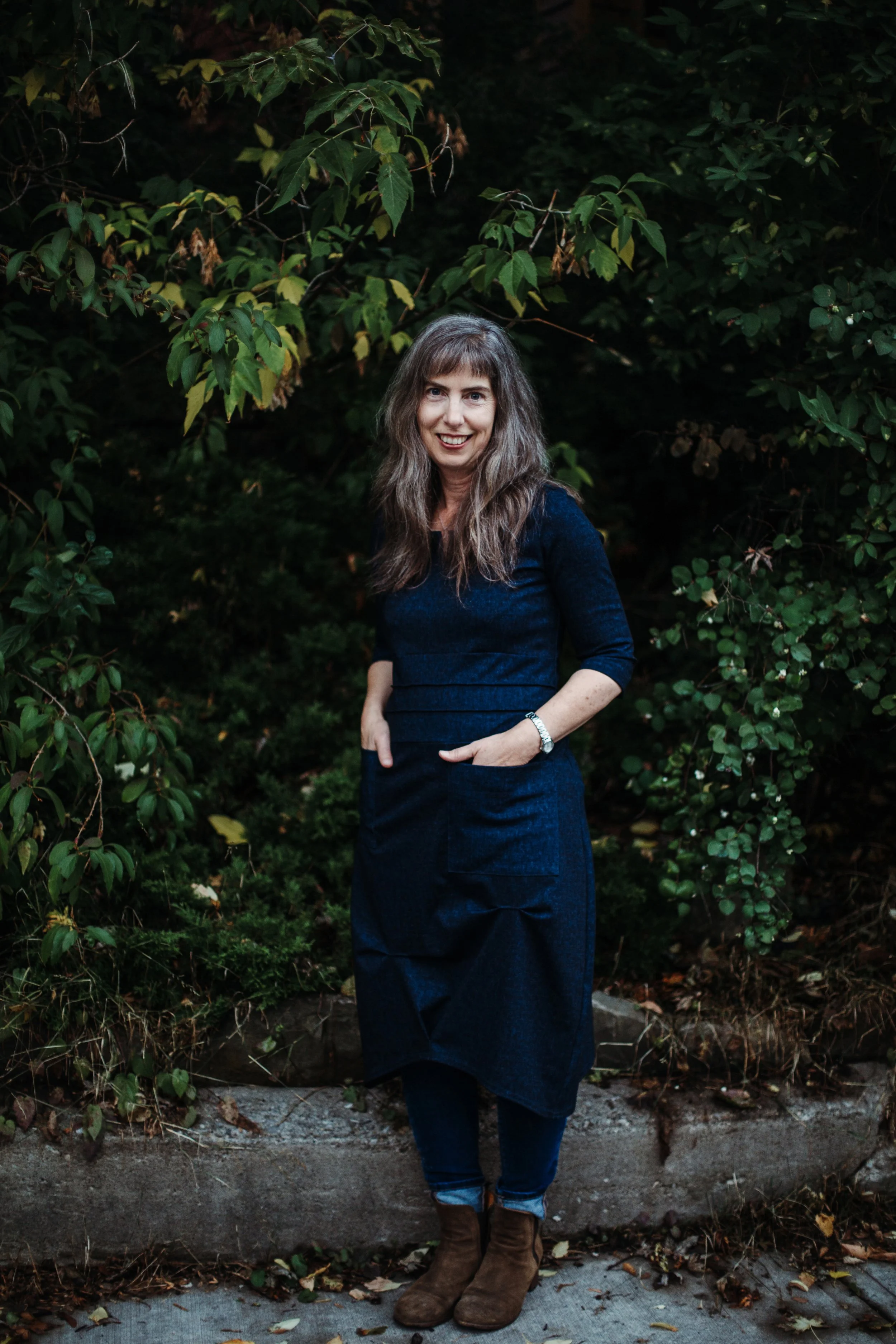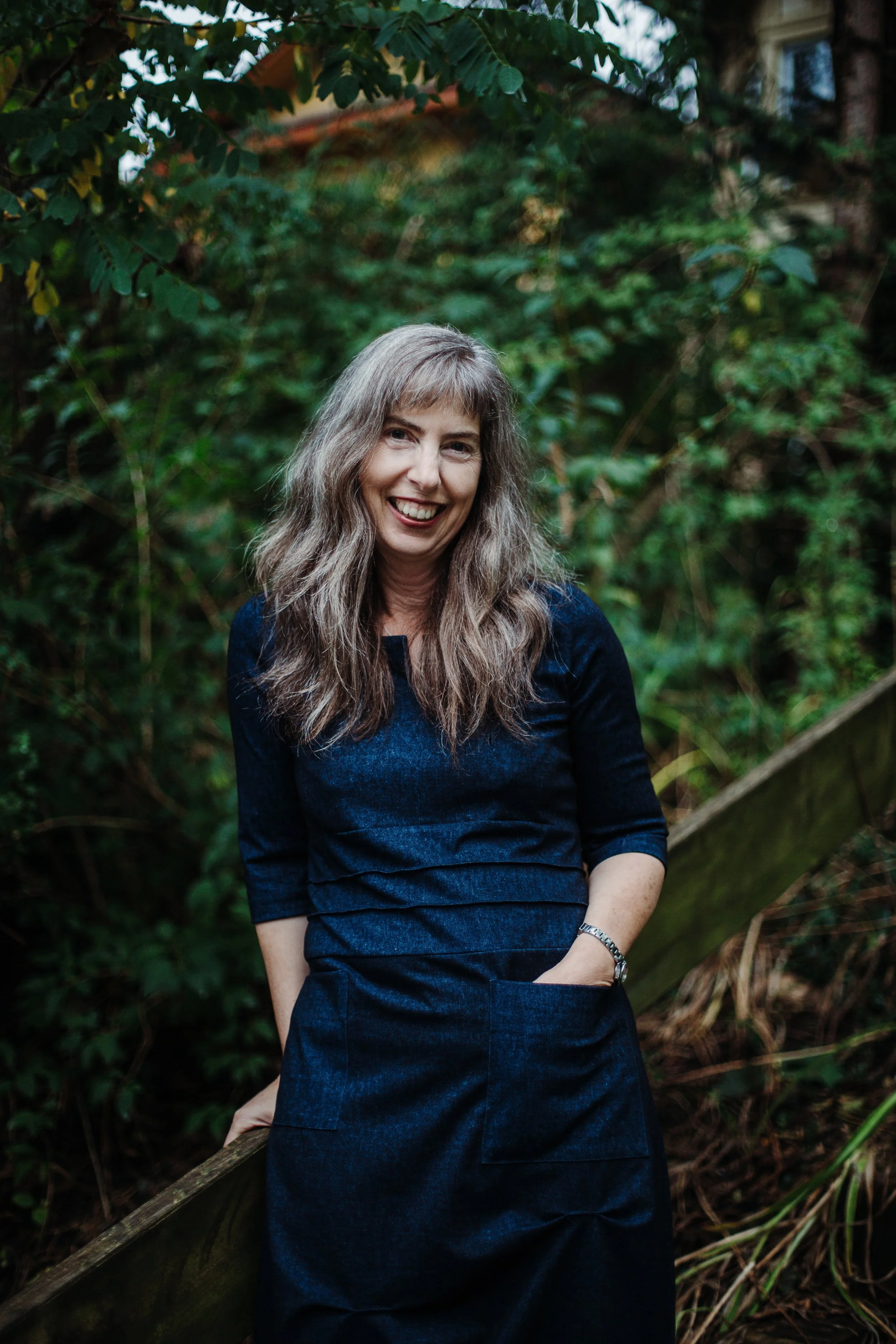The unusual vulnerability of washing a stranger’s feet: My conversation with author Catherine Bush
Catherine Bush (pictured above in a photo by Arden Wray) is the author of Skin, a short story collection published by Goose Lane Editions in 2025. This collection brings together stories from throughout her writing career that showcase her dynamic command of a rich variety of writing styles and unusual subjects.
What's the Idea: Thank you so much for agreeing to meet to talk about your book Skin.
Catherine Bush: It's my pleasure, Matt. It's great to be here.
What's the Idea: Why did you decide to write a short story collection after a career so far of writing novels?
Catherine: Most people publish short stories at the beginning of a writing career and then move on to novels. But I don't think of stories as being the training wheels of writing. Stories are their own art form and they require a lot of hard work to create. Having written five novels, I was interested in setting different challenges for myself. I found myself drawn to flash fiction and micro-stories, which are the complete opposite of a novel. These stories are two or three pages long, so the art is in their absolute compression, bringing the world to the page in this really condensed way and making it explode somehow. I started writing flash; I had a novel that I wanted to work on during the pandemic but it required some travel-related research, which I obviously couldn't do, so I turned to stories instead.
I went back, out of curiosity, to a couple of older story ideas, stories that I had previously drafted, one I think as long ago as the late ’80s. I'd never published them, yet there was still something alive in them, something that deeply intrigued me about the material. This would be the first story, “Benevolence: An East Village Story,” which is set in the ’80s in the East Village in New York, and the story called “Camouflage.” Going back to them as a mature writer meant fundamentally transforming them. And then I just kept writing stories. It was the pandemic and I was looking for a source of pleasure in my writing. Stories became that because they were a new challenge and I could create all these diverse worlds on the page. Then André Alexis, a wonderful writer of both novels and short stories in his own right, said to me that he would like to edit the stories as a collection. He’s been the editor of a couple of other books and we’ve edited each other’s work informally for many years. And that was the point where the project began to formalize itself as a collection of stories.
What's the Idea: That's really interesting. The book feels cohesive while also being a dynamic collection of different styles of writing. It sounds like you were experimenting.
“The AIDS crisis of that first story ricochets against the pandemic stories and the presence of the COVID virus, as well as the thematics about skin and touch and places and times when we can’t touch others, even when we want to... Those concerns permeate the collection.”
Catherine: Yeah, I was exploring different styles. Some stories are more speculative. The ones that touch on the pandemic, for instance, aren't straightforward realism. And then the stories that move towards encounters between humans and the more-than-human world are not straightforward realism either. A man basically falls in love with the wind in one story. And in “Glacial,” a woman has an unusually intimate encounter with a glacier. I wanted the collection to move towards these intimate encounters with the more-than-human world. The collection ends with what is virtually a prose poem in the voice of a great horned owl.
I was interested in assembling all these different voices, and André and I put a lot of thought into how to order the collection. At first I wondered about putting the very short pieces together and making a sequence out of them, but we decided not to do that. It's great to hear you say that the collection has a kind of cohesiveness because Andre and I both really wanted a sense of journey from beginning to end.
Some people don't read the stories in their conceived order. And with a story collection, you're ultimately free to do whatever you want. But I like it when people read the stories in order. The collection starts in the 1980s in New York. I spent some time in the East Village in New York in the ’80s. The book moves up to our current moment. The AIDS crisis of that first story ricochets against the pandemic stories and the presence of the COVID virus, as well as the thematics about skin and touch and places and times when we can't touch others, even when we want to, all that fraughtness despite the desire. Those concerns permeate the collection. I hope the stories resonate against each other in the way in which they're grappling with intimacy and desire.
What's the Idea: The first story, “Benevolence,” pulled me in immediately. I was so intrigued and wanted to understand the intentions of the main character, the teacher.
Catherine: Ellen is a teacher, but she's not, she’s a substitute teacher. She's a performance artist performing as a teacher. And she lets this very charismatic, charming, and vulnerable student stay in the spare room in her East Village apartment. Then of course he won't leave. I was thinking about Melville's Bartleby the Scrivener as one of my points of inspiration. Their relationship becomes very charged. I hope to take the reader to some unexpected places and make the reader question what they want to happen between these two people.
What's the Idea: It certainly did that for me. That story is the longest in the book; it's nearly a third of the collection by page count so it's impressive in and of itself. I'm a big movie fan and I think that story could be very effective if it were adapted for the screen.
Catherine Bush: Maybe one day someone will make a movie of it.
Catherine Bush chose a short story collection as her fifth book because “I was interested in setting different challenges for myself.” (Photo by Arden Wray)
What's the Idea: You mentioned “Camouflage,” which was one of my favorite stories. It was mysterious and intriguing, and it was one of the several stories in the collection that showed a non-judgemental openness to bisexuality. What also struck me was the juxtaposition against the next story “Roxanne (after Edmond Rostand),” which had a totally different style. It seemed like I was reading a classic novel from the 1800s immediately after a very modern story.
Catherine: “Camouflage” begins, as do a lot of the stories, with thefts from other people's stories and also thefts from my own life. Then I radically transform the material. That's how I work as a writer. “Camouflage” was a story a co-worker told me back in the ’80s. I drafted that story several times and never felt like I quite got it right. André first read it years ago and was very fond of it then. It was interesting to return to the material as a mature writer. I completely rewrote the story but there's something about the dynamic of Danny's desire and his ambivalence and trying to figure out who he is and what he wants and his own identity as a kind of escape artist that has always stayed with me.
In “Roxanne,” the story that follows, I wanted to appropriate the story of Edmond Rostand's play Cyrano de Bergerac. I don’t know if you know the play. There have been movie adaptations. Peter Dinklage played Cyrano in the most recent movie version. It's about a man named Cyrano de Bergerac in 17th-century France who has this very long nose and sees himself as ugly even though he's charming and a poet, and he hides behind this beautiful young man to court his (much-younger) cousin.
I wanted to make that material more contemporary and retell it from the point of view of Roxanne, the woman. In the original she's kind of a dupe. She's supposed to be smart, but she's duped by these guys. And I don't believe in her as a dupe. So, I had to reconstruct the story and give her an insight and knowledge that she doesn't have in the original. She's the one making a choice now about what she's going to do and what her own sexuality is going to be and look like. Even though it's set in the past, it has, I hope, a contemporary feel.
What's the Idea: It works so well. I feel like artists and writers feel this pressure to come up with original material but there can be such power in using older ideas and thinking of them from different angles.
Catherine: I think so. I really do. I mean, the originality comes from your take and your voice. My last novel, Blaze Island, is a reworking of Shakespeare's play, The Tempest, in a contemporary setting. The magician Prospero becomes a climate change scientist who gets obsessed with geoengineering and controlling the weather while trying to protect his daughter. I was really interested in taking this old template and reimagining it for our contemporary moment. There's a particular kind of originality that you can get from the old coming up against the new.
Plenty of writers have reinterpreted Shakespeare. There's a long tradition of that and I find this kind of re-engagement fruitful. I don't want to do it all the time, but it is a way of working that definitely interests me. To bring the old and open it up again and make something new out of it.
“You think the story’s so short, it should be easy, but it’s not because every word has to count. Every moment, every juxtaposition.”
What's the Idea: Was there anything specific about flash fiction that really interested you or inspired you?
Catherine: Its absolute brevity and the difficulty of bringing a world to life in two to three pages. One of the earliest flash stories is the title story, “Skin,” which came to me very quickly. Again, I stole a story that I overheard about someone's mother and then completely transformed it. A woman who becomes obsessed with washing strangers’ feet ends up washing the feet of refugees in a refugee center. There’s a strange intimacy to washing others’ feet. In those really short pieces, I wanted to have the energy of juxtaposing unexpected things, pressing unexpected moments against each other.
And so even in that super small space, there's a world, and there are things resonating against each other through contrast and surprise. You think the story’s so short, it should be easy, but it's not because every word has to count. Every moment, every juxtaposition. I was lucky that “Skin” was a story that came to me quite naturally. I've had to rework others more. I'm full of awe for the very short form of flash. I love it and I love it as a reader, too. I love the way a work of flash fiction can burst against you, these small moments that just burst open somehow.
What's the Idea: Honestly, I forgot that “Skin” was one of the flash fiction stories because that story felt so full.
Catherine: It has different movements in it, like musical movements, even though it's two and a half pages long. So, yeah, the challenge is to carry that off.
What's the Idea: Did you set a specific word or page count?
Catherine: No, not with any of them. It's like the idea comes to me in the form of a breath. Each story has its own length of breath and way of breathing. It's very intuitive. I seem to have a natural sense of how long a story is going to be, whether short or longer. And I revise, but when I revise, the length doesn't really change all that much.
What's the Idea: As you worked with André in the editing process, how did the idea for the collection come together and how did it change from what you originally thought this collection might be?
Catherine’s writing has a variety of sources, including taking old templates and updating them. She believes “the originality comes from your take and your voice.” (Photo by Arden Wray)
Catherine: The process of editing was really refining how the stories were going to work together. I was interested in assembling a collection with both really short and really long pieces. There's something I think a little unorthodox about that, about bringing stories of such varied length together, but I think it works. I'm really pleased with the result. The collection originally had a different title that I'm still very fond of. André liked it too. Danger Due To, which is what you see on those signs. Something gets written underneath, like danger due to electrical wires or whatever it is. The collection is full of dangers, but André pointed out, I think fruitfully, that it might be more generative to concentrate on the coming together, on skin as this point of contact. That was already there in all the stories. It wasn't something that we had to infuse the stories with after the fact. It's just like walking in through a different door. Not the danger, but the desire for intimacy. And that made a lot of sense to me.
So when you walk in that door, it's a matter of figuring out the arrangement of rooms and how you're going to walk between them and the juxtapositions created. As you said, I really wanted that juxtaposition between “Camouflage” and “Roxanne.” I was really paying attention to how you move from one story to the other and how the thematics of touch and the presence of skin move from story to story. That became our guiding light.
What's the Idea: After “Roxanne,” you have another piece of very different flash fiction.
Catherine: That one's kind of violent, I must say. It's an intense encounter between a woman and a bird on a highway. It's a jolt, but again, an encounter that ends, despite the violence, with an intimacy. What's the mercy that this woman can show to this dying bird?
What's the Idea: It’s such an intimate collection in the connections between people that it depicts.
Catherine: As I was saying, most of the work in the collection was done during the pandemic. That's when a lot of the original writing of these stories took place. You couldn't not think about touch in those days, and how to find intimacy during those isolating conditions. There were a couple of stories, “Touch” and “Breath,” that write directly into that pandemic moment, but perhaps something of that pandemic existence and the way that touch became so fraught yet desired made the ideas of touch and skin seep into the whole collection. We were aware of our body's porousness at the same time as we were so isolated from others. As a writer, I'm not setting out with an agenda. I just think these things were, unconsciously and consciously, obsessing me at that moment. I'm interested as a writer in unusual kinds of intimacy. The unusual ways we find it, whether it's through washing someone's feet, which is very vulnerable both for the person having their feet washed and the person doing it, or in “Roxanne” again, where the question becomes, is she going to touch Cyrano or not. The whole erogenous zone of touching someone at all becomes very fraught for her. You can have intense intimacy even when you're not touching someone.
“Roxanne” plays against “Benevolence” in that way. In “Benevolence,” this performance artist is working as a teacher and you're certainly not supposed to touch your student. So, how does she navigate that, her desire and intention to do what’s right or good? Those fraught zones are what really interest me as a writer.
What's the Idea: Was having such a varied collection a difficult choice either for yourself or the publisher?
Catherine: I think there might have been questions originally, given the very different lengths of the stories, but both Andre and I were committed to making it work. Once we were committed to doing that, we had to figure out how to do it. It was a matter of finding an order, which worked to bring both the very short and the longer pieces together in a way that created a journey. We arrived at an order that we were both really pleased with in the end.
What's the Idea: I thought the flow of it was great and I liked the variety. I don’t necessarily want to read stories of similar length one after another.
“There is work in this collection that spans my literary career and moves through my life in some fashion from the ’80s to the present moment. The collection has the richness of time and my life in it even though it’s not exactly an autobiography.”
Catherine: I'm glad to hear that. I suppose there might be a temptation, if pressed for time, to read all the short ones and then go back to the longer ones afterwards. But people also say they start reading “Benevolence” and, despite its length, are hooked. They can’t stop reading.
What's the Idea: Were you satisfied with the final published work?
Along with her long career as a writer, Catherine Bush is an Associate Professor of Creative Writing at the University of Guelph. (Photo by Arden Wray)
Catherine: I'm very pleased with the collection. I've been writing since the ’80s. I wrote fiction through college and then in my 20s did a lot of work as a journalist. I published my first novel when I was around 30, so I've been writing and publishing fiction for 30 years. This collection brings together a couple of stories, like “The International Headache Conference” and “Voices Over Water,” which were published long ago and they're still pretty true to their original form. I didn't re-edit them too much, so there is work in this collection that spans my literary career and moves through my life in some fashion from the ’80s to the present moment. The collection has the richness of time and my life in it even though it's not exactly an autobiography. I've described it as a sort of pixelated fictional autobiography, an autobiography in fiction. Those that know my novels have said to me that they see echoes of the concerns of the novels in this book.
I was lucky enough to have a fellowship last year where I was able to really concentrate on revising the stories. I had this intense span of time in Germany that gave me the chance to dive in and work in a concentrated fashion on them altogether.
What's the Idea: How long were you in Germany? What was that experience like?
Catherine: I was in Germany for six months last spring and summer. I had a fellowship at the Rachel Carson Center for Environment and Society. It's for writers and academics who are working in the environmental humanities and have some kind of ecological focus to their work. I was living in a kind of Italian villa with nine other people in the Bavarian countryside outside of Munich, which is where the center is based. Staring out the windows of this tower at the Alps was pretty great.
What's the Idea: That experience sounds like the exact opposite of the pandemic isolation that the stories were written in.
Catherine: Yes, that's very true. Nevertheless, when I was actually writing, I was on my own in this tower room for hours at a time, facing the Alps and facing the stories on the page.
“What I’m trying to do is get closer and closer to the real form and create something that has life. The story has to be more precise and have more depth and have more liveliness, and I can only get there by drafting and redrafting.”
What's the Idea: Was that a process of rewriting?
Catherine: I redraft a lot. The longer stories especially went through really significant re-drafts. I think of myself almost as sculpting on the page. I don't know if that's the best metaphor because that suggests that I just keep stripping something away from a block of stone whereas really what I'm doing is trying out different versions, looking for ever more clarity and vitality.
But like a sculptor, what I'm trying to do is get closer and closer to the real form and create something that has life. The story has to be more precise and have more depth and have more liveliness, and I can only get there by drafting and redrafting. I know that there were times with the most recent story in the collection, “Derecho,” about the man who falls in love with the wind, when André was worried that I wasn't going to get there in time. I said, “Have faith. This is how I work.” When I submitted the final draft to him, he called me up and said, "Okay, it's good. You got there." Which, from him, was a massive compliment.
What's the Idea: Thank you for sharing. It's interesting to hear you're working on another novel. How has working on the short story collection inspired you for that work or any other projects you might do in the future?
Catherine: Having written a collection of stories, I now have all these other ideas for stories that, because I'm working on another novel, I can't pursue right now. The form of this new novel is, at the moment, a little more like a story collection in that it is told in a sequence of different sections. There are also shorter interstitial sections interlaced between the longer ones. Of course, this might change, but maybe Skin is leaving some kind of formal imprint on the new novel.
What's the Idea: It’s so interesting to hear about the process of how you write and how you put the collection together. The richness and detail really came through to me, which must happen through that process of rewriting and reworking.
Catherine: That's what I hope to achieve. Thank you for reading Skin with a great deal of attentiveness and for engaging with the stories as you did. That's such a gift to me as a writer. It really is.
What's the Idea: It was a pleasure to do so. Thank you.
Skin is available for purchase directly from Goose Lane Editions along with your local book store. Follow Catherine Bush on social media for updates on her next projects.
The interview was recorded using Google Zoom in June 2025.
The transcript was edited by Matthew Long, with additional copy editing by Anthony Nijssen of ATP Editing.
All photos are the property of Catherine Bush.



